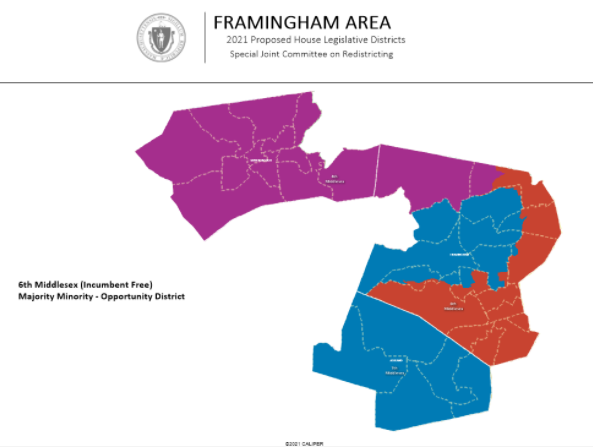Editor’s Note: This report has been updated several times. Last updated at noon on Wednesday, October 13.
***
[broadstreet zone=”58610″]
FRAMINGHAM – Massachusetts released draft maps of proposed state legislative districts this afternoon, October 12.
The public can provide their opinion at a hearing on Friday, October 15. The last day to provide feedback is Monday, October 18.
Co-Chairs of the Special Joint Committee on Redistricting, Senator Will Brownsberger and Representative Mike Moran held a virtual meeting on the proposed plan today, October 12, at 1 p.m., when the proposed maps were unveiled to the public.
Under the proposal, Framingham goes from having three state representatives districts to the the City carved up into 4 state representatives districts, including one Precinct part of a Worcester County district with Westborough, Northborough, and Southborough.
Many City of of Framingham leaders were unhappy with the maps, but State Rep. Jack Patrick Lewis said in a lengthy statement is was a positive for the City of Framingham.
Rep. Lewis would continue to represent all of the Town of Ashland, under the proposal, but he would give up every precinct he currently represents now except for the Precinct he resides in. Under the proposal, he would represent different precincts in Framingham plus the one he resides in.
Mayor Yvonne Spicer was asked for comment at 5 p.m. on Tuesday and as of noon Wednesday she had issued no statement.
State Representative Maria Robinson, who has been nominated for a position in the Biden administration, and Rep. Lewis would both reside in the same legislative district, under the proposal.
“First and foremost, Framingham’s undercount in the 2020 census led to many of the outcomes in redistricting that are being asked about. Had we had results closer to our 2019 counts, which is what early drafts of the redistricting maps considered, the districts would look significantly different. This cannot be emphasized enough,” said Rep. Robinson, who presents a district currently 100% Framingham.
What does Framingham Have for representation now?
Currently, Rep. Robinson, a Framingham resident and a Democrat, current has the sixth Middlesex District, which includes Precincts 1, 2, 4, 5, 6, 7, 9, 10, 11, 12, and 15 in the City of Framingham. It is a completely Framingham-based seat.
Currently, Rep. Lewis, a Framingham resident and a Democrat, represents all of the Town of Ashland and Precincts 8, 13, 14, 16, 17, and 18 in the City of Framingham as part of the 7th Middlesex District.
Currently, Rep. Carmine Gentile, a Sudbury resident and a Democrat, represents Precinct 3 in Framingham, which is part of District 2 in the City of Framingham, as well as all of Sudbury, Wayland, and part of Marlborough as part of the 13th Middlesex District.
[broadstreet zone=”59947″]
What is proposed as representation for Framingham?
Under the draft proposal, a new “minority-majority” Framingham District would be created and would be 100% Framingham based. The goal of this new district is to elect an individual that is ethnical or racial diverse, said the Committee. The new Sixth Middlesex District is 100% Framingham and has no incumbent. It includes all of South Framingham but also parts of Saxonville. Precincts includes are part of 2, 3, 9, 11, 13, 14, 15, 16, 17, and 18.
The 7th Middlesex District is now the Town of Ashland and Framingham Precincts 5, 6, 7, 8, 10 and 12.
Under the proposal, Precinct 1 and part of 2 in Framingham, part of District 1 in the City would become a part of 4th Middlesex District, which also includes the City of Marlborough. The District’s current state representative is Danielle Gregoire, a Marlborough resident and a Democrat.
Under the draft proposal, Precinct 4 in Framingham, which is part of District 3 in the City of Framingham will become part of the Worcester County 19th District which includes the Town of Westborough, The Town of Northborough, and the Town of Southborough.
Representative districts are named for the primary county in which they are located, and tend to stay within one county, although some districts contain portions of adjacent counties.
Each member represented an average of 40,923 residents, as of the 2010 Census. It increased to about 44,000 post the 2020 census.
The new House of Representative and Senate maps must be finalized by November, so candidates can run for office in 2022.
State Senate districts will now be home to roughly 175,000 people.
[broadstreet zone=”70107″]
“These new maps will take us some time to better understand but I am certain that Framingham and its residents will only be better off because of them. The complexities of this statewide process, along with the opportunities possible for a new largely Downtown/Southside/Golden Triangle District, lead me to know that this proposed map is best for Framingham,” said Rep. Lewis.
“Unbelievable! My immediate thoughts, chopping Framingham and its Precincts into unconnected pieces only serves the purpose of protecting the incumbent at the expense of his constituents,” said Framingham City Councilor at-large Janet Leombruno.
The Commonwealth of Massachusetts used the old precinct lines for the City of Framingham in their draft proposal and not the new Precincts and District lines recently approved by the City Council.
“The redistricting process this year has been flawed from the outset, when legislative leadership decided to jump ahead of the local communities. They drew maps with no regards for precincts, new or old, and at least in the case of Framingham it has resulted in a very disadvantageous map,” said City Council Chair George P. King. Jr.
“The House and Senate passed bills to change the process for this year alone and the final bill changing the timeline was signed by the governor into law earlier this month. While the Framingham City Clerk reached out to express concern with this process earlier this year and the House Chair of Redistricting offered to speak with her, the fact is that the new redistricting maps recently passed by the Framingham City Council could not be exclusively used. And because of the creation of a new “Majority-Minority Opportunity District,” the House could not exclusively use the previous precinct lines either. I helped facilitate the sharing of these maps but that couldn’t change this year’s realities,” said Rep. Lewis.
“While the City Council was told last week that the state had accepted Framingham’s new maps, that process this year is separate from our redistricting. Once these new state district lines are voted on, the city council will have a period of time to potentially vote on new local precinct lines if the city doesn’t want situations where precincts are divided between “a” and “b” for house district purposes. While I know Framingham worked diligently to get the new precinct maps drawn, the complexities of this year made it impossible to use those lines as exclusive parameters,” said Rep. Lewis.

The biggest voting Precincts in the City of Framingham are typically District 1 (Precincts 1 &2), District 3 (Precincts 4 and 7), and District 6 (precincts 10 & 11).
“If you live in Precinct 1 or 4 you are for all practical purposes disenfranchised from running for state representative over the next ten years. This process is not the fault of our local representatives, but I hope they are able to advocate for some improvement to what is clearly not currently a good outcome for Framingham,” said Chair King.
“As the first person of color to represent Framingham at the State House, I am excited by the opportunity to have a district that focuses on the needs of Framingham’s people of color in a majority-minority opportunity district. Had the census results been higher in downtown Framingham, it might have been possible to make a South-of-Route-9-Framingham-only district; instead, in order to meet the legally mandated number of residents in a district, some precincts north of route 9 had to be tied to the district,” said Rep. Robinson, a Democrat.
Rep. Robinson is the first Korean-American state representative in Massachusetts.
[broadstreet zone=”59948″] |
“One change made in these redistricting maps is something requested by constituents. Many residents from Precinct 3 (currently represented by Rep. Carmine Gentile) explicitly asked us and the redistricting committee to be included in a Framingham-based district, which is accommodated in this redistricting proposal,” said Rep. Robinson.
“I am confident that all of the voters of Framingham will be well-represented, regardless if their state representative lives or, as is frequently the case, shops, dines, and recreates in Framingham. As someone who sat in countless State House conversations with Rep Carmine Gentile, I can say with certainty that he advocated for Framingham with the same successful passion as he did the rest of his district, as had Tom Sannicandro and Karen Spilka, two former non-Framingham reps who always delivered for our community,” said Rep. Lewis.
“This map weakens Framingham’s voice at the State House,” said Framingham District 8 City Councilor John Stefanini, a former state representative.
“Dividing precinct and neighborhoods disenfranchises voters and weakens their representation,” said Stefanini.
“I am very distraught to see Framingham’s generation’s-long political clout eviscerated by the current redistricting proposal. To split this community into multiple districts where our residents have marginal impact is a travesty. This type of outcome is why sitting legislators have no business being involved in gerrymandering,” said former City Councilor at-large Cheryl Tully Stoll. “Framingham just added residents and lost more than 50% of our political clout in the House of Representatives. A very sad day for a community that needs increased representation—not decreased.”
““This is an important week where Framingham’s leaders should come together to meet, determine the requests, and speak with one voice before the state plan is finalized for the next decade. Together, a series of coordinated, specific recommendations from city officials to state decision makers could change the current state plan to reflect a more fair, balanced, and Framingham centric set of representation. An emergency meeting should have already been scheduled by the Mayor or Council. It is a wasted opportunity if the week goes by and the state does not receive one coordinated city recommendation for the state to consider and hopefully enact,” said School Committee Chair Adam Freudberg.
“As the “Framingham-only” representative, I was primarily invested in seeing a “Framingham-only” seat maintained in redistricting. Other maps showed a universe where only two representatives shared Framingham and Ashland equally, potentially resulting in a situation where both seats were held by Ashland residents. With all due respect to our neighbors, I think it is important that at least one seat is held by a Framingham resident to focus entirely on the needs of our municipality. While we wish that there could be more self-contained Framingham-only districts, this goes back to the undercount in the census. Had we seen higher numbers for Framingham, we may have been able to accommodate two Framingham-only districts,” said Rep. Robinson.
[broadstreet zone=”56696″] |
“As with other major cities, Framingham is expected to see a diverse coalition of representation at the State House, some of whom may reside in other municipalities but work hard for all of the communities they represent. My office plans to brief all state representatives elected to serve Framingham moving forward to help them understand the needs of the community, and I invite constituents to do the same regarding their concerns. Having a larger and more diverse group of representatives advocating for Framingham on Beacon Hill is an asset in budget conversations and helpful in bringing much-needed resources back to our city. I hope that our city can use this redistricting as an opportunity moving forward to maximize funding to make Framingham a stronger, healthier community,” said Rep. Robinson.
[broadstreet zone=”59946″]
City leaders and the public are invited to offer feedback on the draft on Friday.
The Special Joint Committee on Redistricting will hold a virtual hearing for residents of the Commonwealth to offer comments on the draft State Senate and State House maps on Friday, October 15 at 1 p.m.
If you want to provide oral testimony, please click here to sign up. Please be advised that the schedule and agenda are subject to change at the discretion of the chair per committee rules.
To watch the hearing and not tesify visit malegislature.gov.
The committee is accepting public comment on the proposed maps through 5 p.m. on Monday via https://malegislature.gov/Redistricting/Contact.

“Framingham’s current reality of 94% of residents represented by someone who lives in Framingham is a relatively new phenomenon,” said Rep. Lewis. “From 2001 to 2017, only ~60% of Framingham residents were represented by a Framingham resident. Many State House lines span many communities, and it is very common for residents to be represented by someone who lives in a neighboring town.”
“Framingham is not large enough to exclusively contain two state rep districts, especially given the fact that many believe that Framingham residents appear to have been undercounted in last year’s census. Also, with 160 districts needing to be drawn across the Commonwealth, this process is complex. I think the “butterfly effect” is a great way to understand this reality. A small shift in population in one community in one corner of the Commonwealth can require a shift in almost every other district (to guarantee that all districts have similar populations),” said Rep. Lewis.
[broadstreet zone=”59945″] |
“Due to the census delays of the Trump Administration, coupled with the reality of this pandemic, this year’s decennary redistricting needed to be carried out differently at the state level. During “normal years,” there is time for local municipalities to go through the process of local reprecincting prior to the Legislature doing the same for state rep, state senate, and congressional districts. But with the late release of census data, the legislature made it clear several months ago that we would need to move forward with redistricting before (or concurrent to) the work of the local municipalities. There simply wasn’t time to do otherwise,” said Rep. Lewis, a Democrat.
“As was reported earlier this year, there has been a 32% increase in Latino residents and a 22% in Asian residents in Framingham. These facts lead to Framingham being 46.3% non-white,” said Rep. Lewis. “Thus, Framingham can now have a House legislative district drawn that is ‘majority-minority,’ which is noted in the proposed maps as ‘Middlesex 6.'”
“Most of Framingham’s ‘majority non-white’ precincts are south of Route 9 but alone do not include enough people to form a legislative house district, so additional neighborhoods in north Framingham needed to be added. For the first time in a very, very long time, Framingham’s southside, and all of the individual ‘communities of interest’ in that region, will be included in one district. This is positive news for South Framingham to have a representative that focuses attention on the needs of a community that has historically been ignored or diffused,” said Rep. Lewis.
[broadstreet zone=”53820″] |
“.Earlier this year, an outside organization (Drawing Democracy Coalition) sought to also form a majority-minority district here, doing so by connecting South Framingham to Ashland. A choice that would have led to no House districts exclusively contained within Framingham, and could lead to a reality of none of Framingham being represented by someone who actually lives here,” said Rep. Lewis. “While this reality might be surprising to some Framingham residents, the math is pretty clear. I’ll use round approximate numbers. Framingham has a population of 72,000 and ideal state representative districts have approx. 43,000 people. Framingham is not big enough to fully encompass two House districts. And even if it could, the complexities of this process statewide may have made it impossible.”
“So, if we start with the district I currently represent, which continues the long tradition of being a district that includes all of Ashland and part of Framingham, we now have 19,000 Ashland residents. Meaning that somewhere (in this case Framingham), 24,000 residents need to be combined with the 19,000 Ashland residents to form a district. (43,000-19,000= 24,000) So of our total 72,000 residents, 24,000 are then hypothetically included in an Ashland/Framingham district. An additional 43,000 could then be formed to make an exclusively Framingham district, in this case a very strong “Majority-Minority Opportunity District.” Together that includes (43,000 + 24,000= 67,000) 67,000 Framingham residents, leaving us with approximately 5,000 (again, very round numbers) that need to be included in at least one other state rep district. Even if one ignores questions of the majority-minority district and the current vs. future precinct lines, at least several thousand people are going to fall in a third or fourth district,” concluded Rep. Lewis in his statement to SOURCE.


